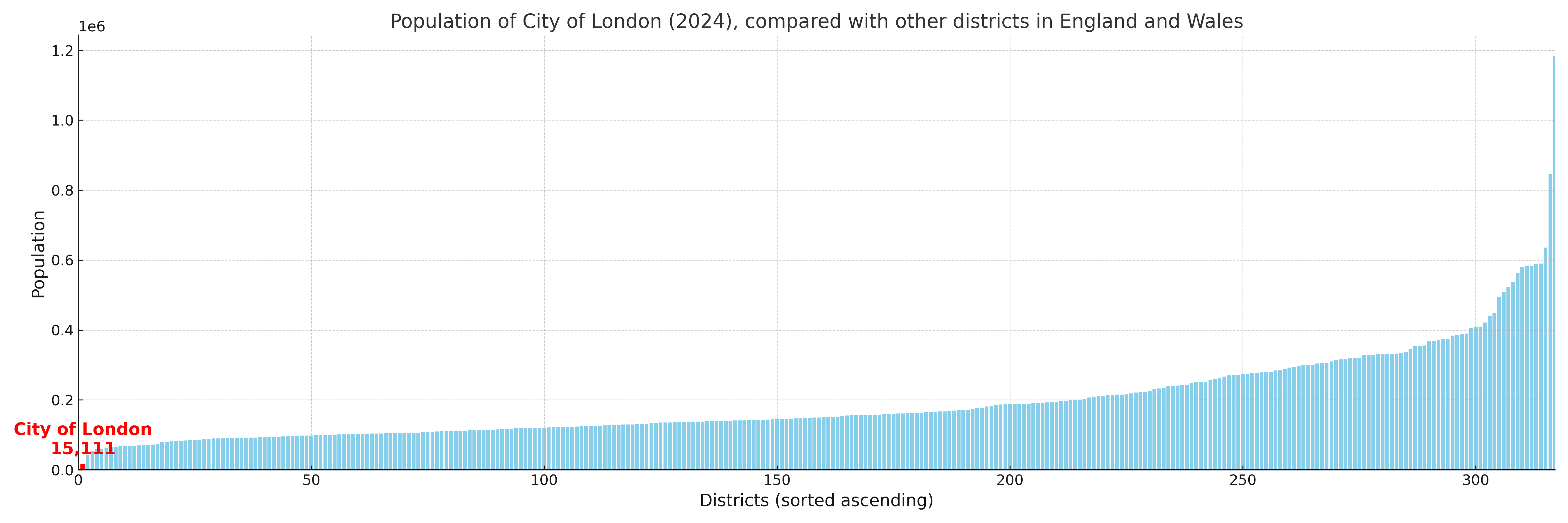City of London
§ This page gives an overview of the City of London local authority district, bringing together key facts, maps, and data to help you quickly understand the area. One of 361 district profiles on Baseview.
Overview ⁞ The City of London is a unique ceremonial county and local authority district at the historic heart of London, covering just over one square mile. Often referred to as the “Square Mile,” it is the original Roman settlement of Londinium and today serves as one of the world’s leading financial centres, home to the London Stock Exchange, the Bank of England, and numerous global banks and institutions. Despite its small size, it has its own police force, the City of London Police, and an unusual system of governance headed by the Lord Mayor of London (distinct from the Mayor of London). The City blends medieval streets, historic landmarks like St Paul’s Cathedral and the Guildhall, and cutting-edge skyscrapers such as the Gherkin and the Cheesegrater. Its permanent residential population is under 10,000, but it hosts hundreds of thousands of workers and visitors each weekday, making it a major hub of commerce, law, and international trade within the UK and beyond.
City of London Boundary Map
This map shows the official boundary of the City of London local authority district, based on the latest geographic data published by the Office for National Statistics (ONS). It provides a clear view of the district’s extent and helps you understand how the area fits within the wider regional and national landscape.
Contains OS data © Crown copyright and database right 2025. Source: Office for National Statistics licensed under the Open Government Licence v3.0.
The administrative boundary of City of London can also be viewed on OpenStreetMap: District Boundary of City of London.
Key Facts about City of London
What region is City of London in? City of London is in the Greater London, an administrative region and a ceremonial county in England.
Is City of London a city? Yes, City of London is a city. City of London holds official city status as one of the 76 designated cities in the UK.
Who governs City of London? The local government for this district is: The City of London Corporation (London Borough).
▶ Official website of The City of London Corporation 🔗 cityoflondon.gov.uk

Which police force covers City of London? Policing in City of London is provided by City of London Police 🔗 cityoflondon.police.uk. The force area is coterminous with City of London (it does not cover other districts).
City of London in International Geographies
In the International Territorial Levels (ITLs) hierarchy, City of London is within an ITLs Level 3 area:
- (ITL 1) London
- (ITL 2) ⇒ Inner London - West
- (ITL 3) ⇒⇒ Westminster and City of London
The International Territorial Levels are used by OECD member countries for statistical purposes to classify administrative areas. We have this listable page for easy browsing of ITL names and codes: International Territorial Levels.
Constituencies in City of London
City of London is divided into 1 parliamentary constituencies, listed below in alphabetical order.
A constituency is a specific geographical area that elects one Member of Parliament (MP) to represent them in the House of Commons. The United Kingdom is divided into 650 parliamentary constituencies, 75 of them are in Greater London (covering 32 London boroughs). We have this list page for easy browsing of all UK parliamentary constituencies: List of Constituencies.
Wards in City of London
City of London is divided into 25 wards, listed below in alphabetical order.
- Aldersgate
- Aldgate
- Bassishaw
- Billingsgate
- Bishopsgate
- Bread Street
- Bridge
- Broad Street
- Candlewick
- Castle Baynard
- Cheap
- Coleman Street
- Cordwainer
- Cornhill
- Cripplegate
- Dowgate
- Farringdon Within
- Farringdon Without
- Langbourn
- Lime Street
- Portsoken
- Queenhithe
- Tower
- Vintry
- Walbrook
In the UK, a ward is a subdivision of a local authority area, used mainly for electoral and statistical purposes. Defined by the ONS, wards represent the primary unit for local elections, each returning one or more councillors to the local council. Wards are also used as a key geography for presenting population and census data.
Parishes in City of London
City of London is entirely unparished—there are no civil parishes in this local authority district.
Parishes are the lowest tier of local government; where they don’t exist, those very local services and representation sit directly with the principal council.
Built-up Areas in City of London
City of London covers 5 built-up areas, listed below in alphabetical order.
- Camden *
- City and County of the City of London *
- City of Westminster *
- Southwark *
- Tower Hamlets *
In the UK, a Built-up Area (BUA) is a continuous urban area of at least 20 hectares (0.2 km²), defined by the ONS as land where buildings are generally no more than 200 metres apart, such as towns, cities, or large villages. (Note: A BUA name marked with an asterisk (*) indicates that the area is situated partly in the district of City of London.)
City of London compared with other districts in the UK
This section shows how City of London compares with other local authority districts in the UK, using a variety of measures and rankings.
City of London has 25 electoral wards.

City of London has a population of 15,111 (2024 mid-year estimate by ONS)

More local statistics and data for City of London can be found on the ONS statistics for City of London.